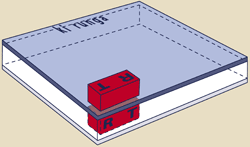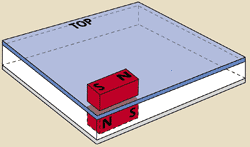|
||||||||||
|
|||||||||||||
| Questions/instructions:
|
|||||||||||||
| %
responses |
|||||||||||||
| 1.
Kei te möhio koe he aha te tikanga o ënei pü (reta)? He äwhina: Ki töu whakaaro, e tohu ana te “R” me te “T” i te aha? What do those letters mean? Prompt: What is meant by N and S? |
N
= North, North pole |
5 |
|||||||||||
S
= South, South pole |
5 |
||||||||||||
| Ki
te kore te äkonga e möhio, mäu e whakamöhio atu, koia
nei ngä pito autö. E tohu ana te “R” i te raki,
e tohu ana te “T” i te tonga. Hoatu ki te äkonga ëtahi autö pepamäro e rua, kua tohua ngä pito ki te “R” me te “T”. If student doesn’t know tell them that these are the magnetic poles, North and South. Give student 2 cardboard magnets marked "N'' and "S". |
|||||||||||||
| 2.
Whakaarohia he autö tüturu ënei. Whakapiria ngä pito
e rua e tohua ana ki te “R”. Ka aha ënei autö, mehemea
he autö tüturu? Waiho te äkonga ki te äta whakaaro, ki te whakahoki körero mai. Imagine that these are 2 magnets. Let’s put together the two ends that are the same. Put the two North ends together. What would happen if these were two real magnets? Allow time for student to respond. |
would
resist, repel |
34 |
|||||||||||
| 3.
He aha te mahi a ngä autö mehemea ka whakapiria ëtahi pito
rerekë? Whakapiria tëtahi o ngä “R”
me tëtahi “T”. Ka aha mehemea he autö tüturu ënei? What might happen when you put two different poles together? Try putting the North and South ends together. What would happen if these were real magnets. |
would
attract |
31 |
|||||||||||
| Waiho
te äkonga ki te äta whakaaro, ki te whakahoki körero mai.
Kätahi ka hoatu ëtahi autö tüturu e rua ki te äkonga.
Whakamätauria ënei autö tüturu. He aha te mahi a ngä autö mehemea ka whakapiria ëtahi “R” e rua? Whakapiria ngä pito “T” e rua. Allow time. Then give the student the two real magnets. Now try testing with the two real magnets. Find out what happens when you put the two North poles together. Then try putting the two South poles together. |
|||||||||||||
| 4.
He aha te mahi a ngä autö ina whakapiria ëtahi pito örite? What happened when you put the same poles together? |
resists/repels |
86 |
|||||||||||
| 5.
Inäianei, whakapiria ëtahi pito rerekë. Whakapiria he “R”
me tëtahi “T”. He aha te mahi a ngä autö? Now try putting two different poles together. Try a North pole to a South pole. What happens? |
attracts
|
86 |
|||||||||||
| 6.
Whakamäramahia mai te tikanga o te autö, arä, he aha te
mahi ina whakapiria ëtahi pito örite, he aha te mahi ina whakapiria
ëtahi pito rerekë? Try to tell me a rule for what happens when you put the same poles together or different poles together. |
not
marked |
• |
|||||||||||
|
|||||||||||||
| 7.
Tuhia ki te pepa whakapiri te wähi e noho ana te autö i roto
i te pouaka. Tohua ngä pito e rua, te “R” me te “T”
o te autö i roto i te pouaka. Now draw on the sticker the position of the magnet that is inside the box. On your drawing, write N where you think North is and S where you think South is on the magnet that is inside the box. |
horizontal
in bottom left corner |
79 |
|||||||||||
| Kia
mutu te mahi a te äkonga, me waiho tana pepa whakapiri ki te pukapuka
hopu körero. When student finishes the task put sticker in recording book. |
|||||||||||||
Total
score: |
7
|
0 |
|||||||||||
5–6
|
33 |
||||||||||||
3–4
|
40 |
||||||||||||
0–2
|
27 |
||||||||||||
| Commentary: Only about a third of students showed prior knowledge about magnets, but most correctly reported experimental results. |
|||||||||||||
|
|
|
|

